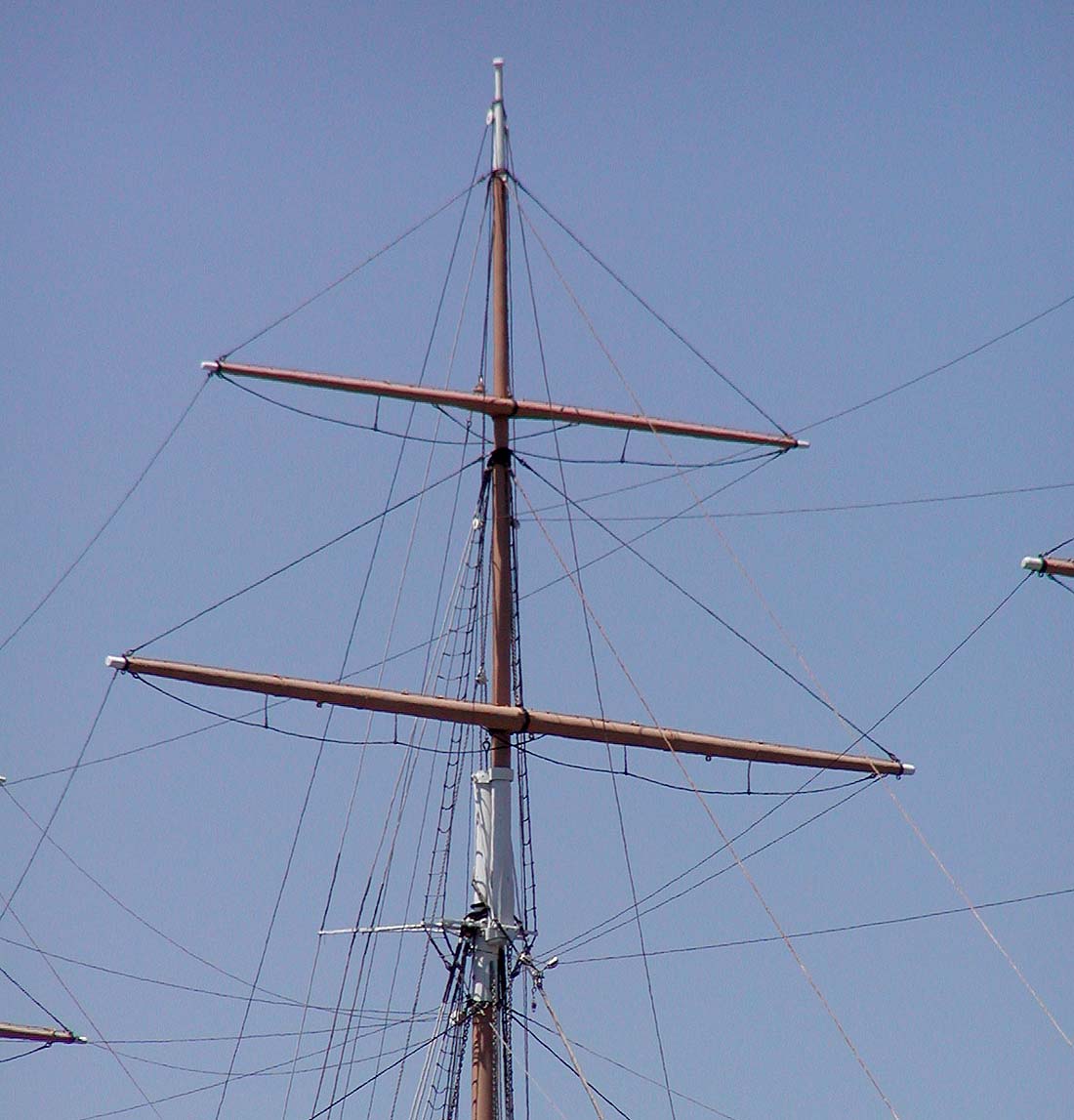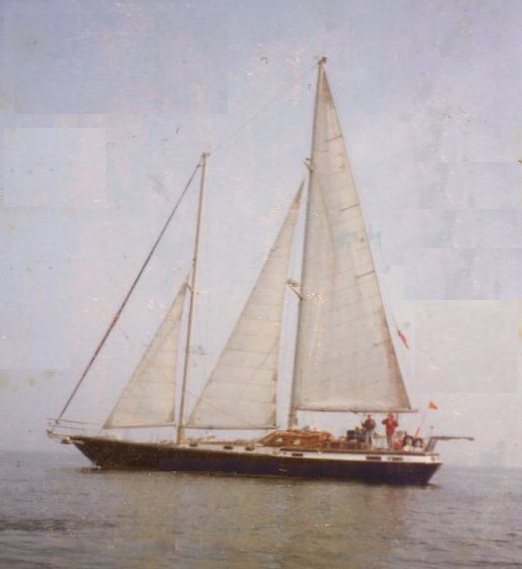|
Topgallant Sail
On a square rigged sailing vessel, a topgallant sail (topgallant alone pronounced "t'gallant", topgallant sail pronounced "t'garns'l",C.S. Forester, ''Beat to Quarters'', Chapter VI. is the square-rigged sail or sails immediately above the topsail or topsails. It is also known as a gallant or garrant sail. Later full-rigged ships split the topsail (and often the topgallant sail) for easier handling. They thus set two topsails (and possibly two topgallant sails) per mast. The lower topgallant sail is immediately above the upper topsail. The upper or only topgallant sail is set from the top of the topgallant mast. If there is a lower topgallant it is set from midway down the topgallant mast. A staysail A staysail ("stays'l") is a fore-and-aft rigged sail whose luff can be affixed to a stay running forward (and most often but not always downwards) from a mast to the deck, the bowsprit, or to another mast. Description Most staysails a ... set on a stay running forward ... [...More Info...] [...Related Items...] OR: [Wikipedia] [Google] [Baidu] |
Krusenstern Topgallant Sails
Krusenstern or Kruzenshtern may refer to: * Adam Johann von Krusenstern (1770–1846), Baltic German admiral and explorer who circumnavigated the world in Russian service Places named after von Krusenstern * Krusenstern (crater), on the Moon * Krusenstern Island (other) ** A small group of islands in the Middendorff Bay ** Little Diomede Island, in Alaska ** Ailuk Atoll, in the Marshall Islands ** Tikehau-Atoll, of Tuamotu Archipelago in French Polynesia ** Krusenstern Island, Krusenstern Reef, or Krusenstern Rock, a phantom reef south of the Northwestern Hawaiian Islands * Krusenstern Strait, Kuril Islands, Russia * Cape Krusenstern, in Alaska ** Cape Krusenstern National Monument in Alaska * Mount Krusenstern, Novaya Zemlya, Russia Other uses * Kruzenshtern (ship), ''Kruzenshtern'' (ship) (until 1946 German ''Padua''), a Russian tall ship training vessel * Krusenstern field, a List of natural gas fields, natural gas field in Russia * Cape Krusenstern, at the west end ... [...More Info...] [...Related Items...] OR: [Wikipedia] [Google] [Baidu] |
Square Rig
Square rig is a generic type of sail plan, sail and rigging arrangement in which a sailing ship, sailing vessel's primary driving sails are carried on horizontal spar (sailing), spars that are perpendicular (or wikt:square#Adjective, square) to the median plane of the keel and masts of the vessel. These spars are called and their tips, outside the lifts, are called the . A ship mainly rigged so is called a square-rigger. In "customs and traditions of the Royal Navy, Jackspeak" (Royal Navy slang), it also refers to the uniforms of the Royal Navy, dress uniform of Junior Ratings. History Single sail square rigs were used by the ancient Egyptians, the Phoenicians, the Greeks, the Romans, and the Celts. Later the Scandinavians, the Germanic peoples, and the Slavs adopted the single square-rigged sail, with it becoming one of the defining characteristics of the classic “Viking” ships.The Viking ship's single square-rigged sail. http://Longshipco.org/sail.html Retrieved 2018-8- ... [...More Info...] [...Related Items...] OR: [Wikipedia] [Google] [Baidu] |
Sailing
Sailing employs the wind—acting on sails, wingsails or kites—to propel a craft on the surface of the ''water'' (sailing ship, sailboat, raft, Windsurfing, windsurfer, or Kitesurfing, kitesurfer), on ''ice'' (iceboat) or on ''land'' (Land sailing, land yacht) over a chosen Course (navigation), course, which is often part of a larger plan of navigation. From prehistory until the second half of the 19th century, sailing craft were the primary means of maritime trade and transportation; exploration across the seas and oceans was reliant on sail for anything other than the shortest distances. Naval power in this period used sail to varying degrees depending on the current technology, culminating in the gun-armed sailing warships of the Age of Sail. Sail was slowly replaced by steam as the method of propulsion for ships over the latter part of the 19th century – seeing a gradual improvement in the technology of steam through a number of developmental steps. Steam allowed schedul ... [...More Info...] [...Related Items...] OR: [Wikipedia] [Google] [Baidu] |
Topsail
A topsail ("tops'l") is a sail set above another sail; on square-rigged vessels further sails may be set above topsails. Square rig On a square rigged vessel, a topsail is a typically trapezoidal shaped sail rigged above the course sail and below the topgallant sail where carried, on any mast (i.e., a fully rigged ship would have a foremast topsail, a mainmast topsail, and a mizzen topsail). A full rigged ship will have either single or double (i.e., "split" upper and lower) topsails on all masts, the single or lower topsail being the second sail above the deck and the upper topsail where so rigged being the third. Although described as a "square" sail, a topsail on a full rigged ship refers not to the sail's shape but to it and its yard being rigged square (i.e., at a right angle) to the vessel's keel rather than in line with it (in which case it would be called a fore-and-aft rig or a fore-and-aft rigged sail) ; a square rigged topsail is nearly always trapezoidal in sha ... [...More Info...] [...Related Items...] OR: [Wikipedia] [Google] [Baidu] |
Full-rigged Ship
A full-rigged ship or fully rigged ship is a sailing ship, sailing vessel with a sail plan of three or more mast (sailing), masts, all of them square rig, square-rigged. Such a vessel is said to have a ship rig or be ship-rigged, with each mast stepped in three segments: lower, top, and topgallant. Masts The Mast (sailing), masts of a full-rigged ship, from Bow (ship), bow to stern, are: * Foremast, which is the second tallest mast * Mainmast, the tallest * Mizzenmast, the third tallest * Jiggermast, which may not be present but will be fourth tallest if so If the masts are of wood, each mast is in three or more pieces. They are (in order, from bottom up): * Th''e mast or the lower.'' * Topmast * Topgallant mast * Royal mast, if fitted On steel-masted vessels, the masts are not constructed in the same way, but the corresponding sections of the mast are still named after the traditional wooden sections. Sails The lowest and normally largest sail on a mast is the course ( ... [...More Info...] [...Related Items...] OR: [Wikipedia] [Google] [Baidu] |
Topgallant Mast
The mast of a sailing vessel is a tall spar, or arrangement of spars, erected more or less vertically on the median line of a ship or boat. Its purposes include carrying sails, spars, and derricks, giving necessary height to a navigation light, look-out position, signal yard, control position, radio aerial, or signal lamp. Large ships have several masts, with the size and configuration depending on the style of ship. Nearly all sailing masts are guyed. Until the mid-19th century, all vessels' masts were made of wood formed from a single or several pieces of timber which typically consisted of the trunk of a conifer tree. From the 16th century, vessels were often built of a size requiring masts taller and thicker than from single tree trunks. On these larger vessels, to achieve the required height, the masts were built from up to four sections (also called masts). From lowest to highest, these were called: lower, top, topgallant, and royal masts. Giving the lower sections su ... [...More Info...] [...Related Items...] OR: [Wikipedia] [Google] [Baidu] |
Staysail
A staysail ("stays'l") is a fore-and-aft rigged sail whose luff can be affixed to a stay running forward (and most often but not always downwards) from a mast to the deck, the bowsprit, or to another mast. Description Most staysails are triangular; however, some are four-cornered, notably some fisherman's staysails. Triangular staysails set forward of the foremost mast are called jibs, headsails, or foresails. The innermost such sail on a cutter, schooner, and many other rigs having two or more foresails is referred to simply as ''the staysail'', while the others are referred to as jibs, flying jibs, etc. Types of staysail include the tallboy staysail (a narrow staysail carried between the spinnaker and the mainsail on racing yachts), the genoa staysail (a larger one carried inside the spinnaker when broad reaching), and the bigboy staysail (another name for the shooter or blooper, carried on the leeward side of the spinnaker). Unlike the cutter staysail, none of ... [...More Info...] [...Related Items...] OR: [Wikipedia] [Google] [Baidu] |





